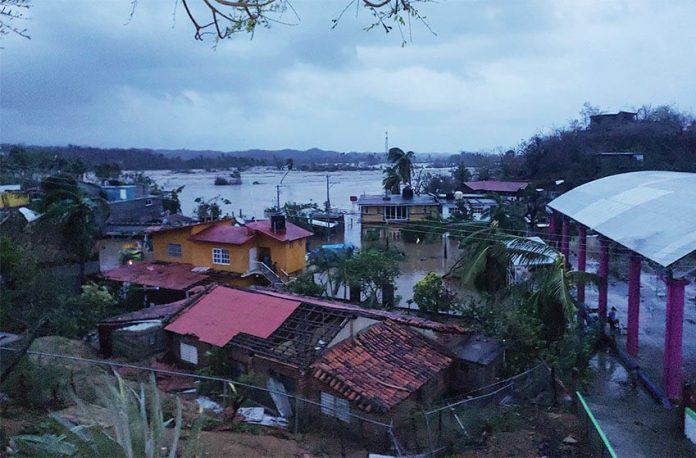The neighboring coastal municipalities of San Pedro Pochutla and Santa María Tonameca face a long road to recovery after they bore the brunt of Hurricane Agatha, a Category 2 storm that made landfall in Oaxaca on Monday.
After assessing the situation in the former municipality, local authorities reported that approximately 38,000 people suffered damage to their homes or other property.
San Pedro Pochutla, which includes the coastal towns of Puerto Ángel and Zipolite, is one of six municipalities where federal authorities have declared an extraordinary emergency situation.
In an emergency declaration application sent to President López Obrador and Oaxaca Governor Alejandro Murat, Pochutla Mayor Saymi Adriana Pineda Velasco said the full extent of the damage Agatha caused to homes, schools and churches had not yet been established.

She called for supplies including water, food, blankets, sleeping mats and medications to be sent to the municipality. Pochutla is one of several municipalities where the military is distributing aid, but as is common in Mexico in the aftermath of disasters some communities say they have been neglected.
In Santa María Tonameca, authorities reported that approximately 7,000 families in some 50 communities were affected by Agatha, the most powerful hurricane to have made landfall in the Eastern Pacific in May.
Mayor César Ruíz Gutiérrez also requested an emergency and disaster declaration for his municipality, which includes the beach town of Mazunte. It was not among the six municipalities for which the federal government made an emergency declaration.
The other five municipalities included in the declaration were Santa María Colotepec, Santo Domingo de Morelos, Santa María Huatulco, San Miguel del Puerto and San Pedro Huamelula. The Oaxaca government has called for 26 municipalities to be declared disaster and emergency zones.
One Pochutla community devastated by the strong winds and heavy rain brought by Agatha is Zapotengo, population 200. Roads into the community remain cut off and homes were rendered unlivable, the newspaper Milenio reported Thursday.
Powerful wind ripped sheet metal roofs off homes, many of which were inundated with mud. Electricity and water service was cut in the small community and residents say they haven’t received any assistance from authorities.
María de la Luz Cantera Cruz, an approximately 60-year-old woman who shared a three-room home with 13 family members, told Milenio that they lost all their belongings. “We’re left without clothes, without anything, we lost everything,” she said.
“I’m asking the federal government to help us because the truth is this is very painful. … I’m very hurt, very sad and the truth is sometimes I would prefer not to be here,” Cantera said.
#EnFotos Así se ven los daños que dejó el huracán Agatha tras impactar en territorio de San Pedro Pochutla, Costa de #Oaxaca. Se reporta al menos una niña fallecida, deslaves, derrumbes y casi 24 horas sin luz ni señal telefónica.
➡️ https://t.co/TNuR3E3mdn
📸 Fernando Miranda pic.twitter.com/cFwvzjOYkQ— El Universal Oaxaca (@ElUniversalOax) May 31, 2022
“… [The hurricane] took the roof [of our home], the bed, everything, … the fridge, dishes, all the appliances that we’ve bought bit by bit thanks to God,” she said.
Cantera told Milenio that she and her family have been sleeping outside next to their damaged home since Agatha struck because they have no way to get to a shelter. “We’re suffering a lot, we don’t have anywhere to sleep,” she said.
Another Zapotengo resident said that practically all her furniture was washed away by a raging creek.
“The good thing is that my husband, my children and I managed to get out … in time because the creek was bearing down on us,” Zoila Velázquez said, adding that her chickens were also washed away.
Eliana Trinidad, whose home was also inundated with water and mud, said her family has no food or water.
Some Zapotengo residents claimed that Agatha was the most powerful hurricane of recent decades, even surpassing Pauline, a Category 4 hurricane that made landfall near Puerto Ángel in October 1997 and claimed hundreds of lives.
About 30 kilometers west of Zapotengo is San Isidro del Palmar, a community of about 1,000 people that was also ravaged by Hurricane Agatha.
“I think the eye of the hurricane arrived here because the wind and rain were very strong,” Óscar Ortiz, a resident, told the newspaper El Universal.

“Sheet metal roofs and homes were completely destroyed, a lot of homes were overwhelmed by water,” he said, adding that some houses were flooded by as much as three meters of water.
San Isidro, located in Santa María Tonameca, was also cut off due to flooding and the damage Agatha caused to roads.
Residents, many of whom lost their homes and possessions, told El Universal they weren’t told to evacuate before the hurricane arrived and complained that aid was taking too long to arrive. Locals also said the damage caused by Agatha is greater than that produced by Pauline. “Unfortunately we don’t have anywhere to live,” Ortiz said.
In Macahuite, another Santa María Tonameca community, a group of women told El Universal that no supplies have arrived.
“They’ve abandoned us, we don’t have food or water to drink. There are small children and seniors in need. Nothing has reached us,” one woman said.
Governor Murat, who visited hurricane-ravaged communities on Thursday, told El Universal that the army and the navy are the only authorities authorized to deliver aid and are doing so “in accordance with the protocols.”
He said that authorities will respond to the damage in a gradual way and noted that the total number of victims has not yet been established.
“The censuses are only just beginning. We’re still in an emergency stage, which is aimed at saving lives and at the same time supplying what is essential … [for survival], which is food and shelter,” Murat said.
The governor reported Friday morning that the hurricane death toll remained at nine – two fewer than previously reported – and that five people were missing.
With reports from El Universal and Milenio
